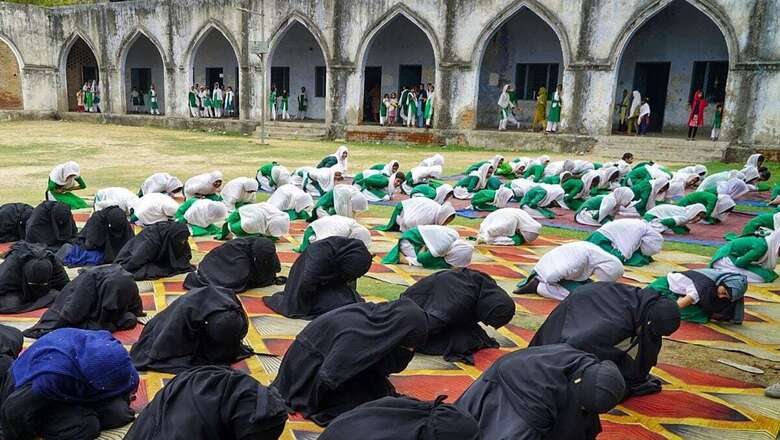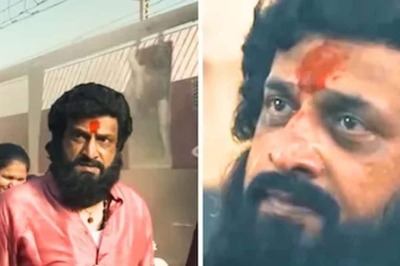
views
The National Commission for Protection of Child Rights (NCPCR) Chairperson, Priyank Kanoongo, recently raised an alarm over the ‘radical’ curriculum in government-funded madrasas (Islamic seminaries) in Bihar, where books allegedly published in Pakistan are being taught. In a Hindi post on ‘X’ (formerly Twitter) on August 18, 2024, he cited a catechism in Taleem-ul-Islam Book-I: Lessons in Islam (P.6), which clearly states that unbelievers in Islam (kafirs) and Mushriks (polytheists) will never attain salvation and will instead be doomed to eternal punishment and affliction.
बिहार राज्य में सरकारी फ़ंडिंग से चलने वाले मदरसों में तालिमुल इस्लाम व ऐसी ही अन्य किताबें पढ़ाई जा रहीं हैं,इस किताब में ग़ैर इस्लामिकों को काफ़िर बताया गया है।इन मदरसों में हिंदू बच्चों को भी दाख़िला दिए जाने की सूचना मिली है परंतु बिहार सरकार संख्या अनुपात की अधिकारिक… pic.twitter.com/vjySGSjxrQ— प्रियंक कानूनगो Priyank Kanoongo (@KanoongoPriyank) August 18, 2024
The syllabus in question was prepared by the Bihar State Madrasa Education Board in collaboration with the UNICEF office, Bihar, after a series of workshops, trials and feedback, according to Asadur Rahman, Chief Field Office, UNICEF, Bihar.
While this exposure may be sensational, it is nonetheless unexceptional. The curriculum in Bihar’s madrasas does not constitute a departure from the fundamental tenets of Islam, which are consistent from Mauritania to Indonesia. To assume that students in the madrasas of Bihar are being taught a fundamentally different version of Islam than those in the madrasas of Uttar Pradesh, Gujarat, West Bengal, or Telangana would be erroneous. It is likely that only the study material of Bihar’s madrasas has been scrutinised, to the exclusion of those in other states.
Islam’s opposition to idol worship, polytheism, and atheism is fundamental in nature. It is as elemental as the three states of water—solid, liquid, and gaseous—as taught in physics. From the standpoint of Islamic dogma, there is logic behind this stance. Idol worship and polytheism are incompatible with the belief in the singularity of Allah (Tawhid). Historically, the ascendancy of Islam was accompanied by the eradication of polytheism and idol worship in the Arabian Peninsula during the lifetime of the Prophet of Islam. After the conquest of Mecca (630 AD), the idols adorning the Ka’ba were gathered, burned, and smashed.
Syed Abul Hassan Ali Nadwi, alias Ali Mian (1913-1999), independent India’s foremost scholar and thinker, describes it in simple terms: “Belief in the Oneness of Allah, Tawheed in Arabic, is a pure and unmatched article of faith in Islam. Under this article, there is no need for an intermediary between God and His servant, who would intercede in matters of supplication and worship. This belief leaves no room for polytheism, the idea of someone being God’s incarnate or shadow, and doctrines of transmigration and the merger of Creator and creature” (A Short Presentation on Islam, p. 3-4).
Affirming the exclusivity of Allah and censuring disbelief (and disbelievers) is an integral part of Islam. Islam’s approach is thus entirely at odds with Hinduism, which acknowledges multiple approaches to the Truth. From Islam’s standpoint, there could certainly be no parity or equivalence between the believer (momin) and the non-believer (kafir).
Karl Marx (and this is for the benefit of Left-liberals) demonstrated a nuanced understanding of Islam when he stated: “The Koran and the Mussulman legislation emanating from it reduce the geography and ethnography of the various people to the simple and convenient distinctions of two nations and of two countries; those of the Faithful and those of the Infidels. The Infidel is ‘haraby’, i.e. enemy. Islamism proscribes the nation of the Infidels, constituting a state of permanent hostility between Mussulmans and the unbeliever” (Declaration of War—On the History of Eastern Question, New York Herald Tribune, April 15, 1854).
Dr BR Ambedkar (1946) captures this divide brilliantly: “Islam divides as inexorably as it binds. Islam is a close corporation, and the distinction it makes between Muslims and non-Muslims is a very real and very positive. The brotherhood of Islam is not the universal brotherhood of man. It is the brotherhood of Muslims for Muslims only” (Pakistan or the Partition of India, P.325).
II
This is not the first time that serious concerns have been raised about the madrasa curriculum. Shortly after the shooting incident outside the American Centre in Kolkata on January 22, 2002, then West Bengal Chief Minister Buddhadeb Bhattacharya stated that certain unrecognised madrasas operating in areas bordering Bangladesh had become hubs for ISI-inspired terror-linked activities. His remarks caused significant uproar, not only within the Muslim community but also within the ruling CPI(M).
However, what Bhattacharya stated was not entirely without basis, as evidenced by a video clip in the documentary film Bangla Crescent (2005), directed by Delhi-based filmmaker Mayank Jain. The film (see clip from 58:37 to 1:02:24) shows young students of a madrasa on the Indo-Bangladesh border with clear notions of jihad against kafirs.
III
According to the Council of Boards of School Education’s (COBSE) website, only seven states in India—Assam, Bihar, West Bengal, Chhattisgarh, Uttarakhand, Uttar Pradesh, and Odisha—have state madrasa boards. These boards focus on Islamic studies, including the Quran, Hadith, and Fiqh (Islamic jurisprudence). Bihar is one of the states with a madrasa board in place. However, the situation in the majority of Indian states, where there are no madrasa boards, is best left to the imagination.
As per information provided by Mukhtar Abbas Naqvi, the then Minister of Minority Affairs in Rajya Sabha, in reply to a question by Rakesh Sinha (vide unstarred question no 118 dated February 3, 2020), there were 19,132 recognised madrasas and 4,878 unrecognised madrasas in the country for the financial year 2018-19 (with several states not providing figures). Madrasas fall into two categories: Madrasa Darse Nizami, which imparts education in Arabic, Persian, and Urdu and is not required to follow state-approved curricula; and Madrasa Darse Aliya, which adheres to the curriculum prescribed by the state education boards.
This appears to be an understatement, as would be evident from the information provided by the Ministry of Minority Affairs before the Department-Related Parliamentary Standing Committee on Social Justice and Empowerment (2021-22). The Committee’s 33rd report (2022) on the Demand for Grants (2022-23) for the Ministry of Minority Affairs indicates that a total of 11 states did not provide any data on madrasas on the UDISE portal, while 10 states, including Haryana, Himachal Pradesh, Karnataka, Kerala, Meghalaya, Punjab, and Tamil Nadu, have between 1 and 20 madrasas registered on the portal.
However, of this moth-eaten data, there were 26,928 registered madrasas for the financial year 2019-20. Of these, 1,425 were government-managed, 979 were government-aided, and 26,186 were private. They employed 117,272 regular teachers, 28,251 contractual teachers, and 1,225 part-time teachers. The total enrollment of boys and girls was 4,352,303 (vide Para 6.11 to 6.12/P.50). This represents a notable improvement over the UPA years when officials from the Ministry of Minority Affairs had admitted before the Parliamentary Standing Committee that no centralised data on madrasas was maintained. Yet, the mismatch in data was deplorable.
According to a report by NIEPA (2018), the curriculum of madrasas in India is regulated by three major Islamic institutions: a) Darul Uloom Deoband, b) Darul Uloom Nadwatul Ulama, Lucknow, and c) Jamiat ul Hidaya, Jaipur. These institutions focus on different grades and subjects (Evaluation of SPQEM, 2018, P.21). The report is limited to four states—Chhattisgarh, Madhya Pradesh, Tripura, and Uttar Pradesh—and does not provide a nationwide overview.
On August 20, 2001, the then HRD Minister, Murli Manohar Joshi, while inaugurating the All India Urdu Editors’ Conference, clarified that the Vajpayee government had no intention of altering the religious curriculum of madrasas. However, the government was interested in modernising madrasas by introducing subjects such as Science, Mathematics, Social Sciences, and General Knowledge. The Vajpayee government increased expenditure on madrasa education from Rs 2 crore to Rs 12 crore.
Thus, this “modernisation” of madrasa education meant an add-on to religious education, which was left uninvestigated and unreformed. This later formed the basis for the Scheme for Providing Quality Education in Madrasas (SPQEM) introduced by the UPA government in November 2008.
The Vajpayee government began setting up IT centres for minorities in various districts. This initiative has often been described by Prime Minister Narendra Modi as “Ek haath mein Quran, Ek haath mein computer” (The glorious Quran in one hand, computer in the other). It is overlooked that this policy could mean providing a modern tool to advance a medieval mindset. Zulkifar Ali Barodawala, the alleged mastermind behind the Pune ISIS module, was an IT engineer who earned a handsome salary of Rs 31 lakhs per year before being arrested by the Maharashtra ATS in July 2023. The notion that a ‘computer’ can modernise one’s mindset is outdated, akin to the idea that the internet can ‘democratise’ elections. Nowadays, fake news and false narratives, rapidly spread via social media, pose a significant threat unlike in the pre-IT era.
Only seven states in India have a madrasa board, as mentioned above. However, the rules are reportedly so lax that one could start a registered madrasa in a 10 ft by 10 ft room. Often, these institutions lack basic facilities such as blackboards, chairs, tables, toilets, or playgrounds. The area of madrasa education remains a grey area that warrants the publication of a White Paper.
The writer is author of the book ‘The Microphone Men: How Orators Created a Modern India’ (2019) and an independent researcher based in New Delhi. Views expressed in the above piece are personal and solely that of the author. They do not necessarily reflect News18’s views.

















Comments
0 comment